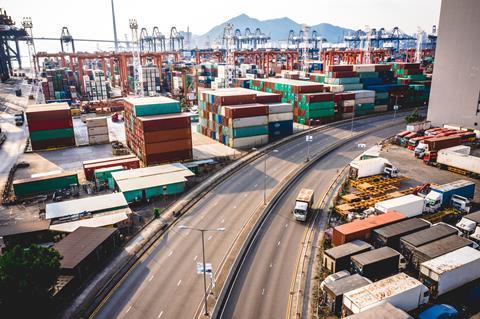Sustainability, technology, and geopolitical challenges are top supply chain risks for the $9.7 trillion global transport and logistics industry
The transportation and logistics industry underpins $89bn of global trade and has a market value of $9.7trn USD.
The supply chain disruption experienced during the COVID-19 pandemic and more recently in relation to ongoing geopolitical conflict, has highlighted the fragility of supply chains to global impacts, and the importance of building resilience into risk management solutions.

A new Lloyds report, delivered in collaboration with WTW found that over 90% of transport and logistics companies surveyed agree that insurance for supply chain risk is critical.
However, an alarming 77% said a lack of access to supply chain insurance solutions, and a lack of data to understand these risks were among the greatest challenges to their businesses.
Some supply chain risks are within an organisation’s control and others – like geopolitical risks or extreme weather – have systemic elements that go beyond the balance sheet of any single institution.
Key takeaways from the report
- Transportation and logistics companies have always been at the sharp end of supply chain risk and respond to operational events and balancing capacity every day. They take risk seriously: investing heavily in redundancies, ensuring they have robust contingencies in place, sharing resources and building partnerships within the industry. As seen in the semiconductor industry, transportation and logistics companies have deep partnerships within their industry
- Six key supply chain risks and drivers are currently at the forefront of the minds of transportation and logistics businesses: sustainability, decarbonisation and ESG; technology; labour; business model; and regulation. Global trade, geopolitics and geoeconomic risk were other key issues highlighted in discussions with businesses in the sector
- Most companies demonstrated a rising awareness of risk and growing complexity as companies acquire different modes to gain greater control over delivery and inherit their risk landscape and regulatory responsibilities. However the research has shown a range of risk maturity with some very advanced in their journeys and others knowing they need to catch up. There was also a range of understanding of supplier resilience, ranging from high level information only to progressive part sharing warehouses with competitors to pool resources
- The insurance industry can play a significant role in the protection of the billions of dollars’ worth of investment being made in transportation and logistics. Increased collaboration can provide opportunities for insurers to demonstrate the value of insurance and grow in partnership with the transport and logistics sector.
Trends to watch
The report identified nine recent trends affecting transportation and logistics supply chains.
- E-commerce: The rise of online shopping since 2000, and particularly since the COVID-19 pandemic, has led to an increase in demand for faster and more efficient delivery of goods. As a result, transportation and logistics companies are investing in new technologies to improve their operations and meet customer expectations
- Sustainability: There is growing concern about the environmental impact of transportation and logistics. As a result, companies are investing in alternative fuels, electric vehicles, and other sustainable technologies to reduce their carbon footprint
- Climate risks: In 2022, the world saw major examples of transportation disruptions can result from drought. The Mississippi River, for example, carries 92% of U.S. agricultural exports, and its water levels dropped to the lowest levels in 34 years40. Drought also impacted key European rivers and water scarcity lowered summer crop yields
- Digitalisation: The adoption of digital technologies, such as the Internet of Things (IoT), cloud computing, and artificial intelligence, is transforming the transportation and logistics industry. These technologies are enabling companies to optimise their operations, reduce costs, and improve customer service
- Supply chain disruptions: The pandemic has had a significant impact on the transportation and logistics industry. Restrictions on movement, supply chain disruptions, and reduced demand for some goods and services have affected companies across the industry. Other events such as the Suez Canal blockage in March 2021, which disrupted global supply chains and caused delays and increased costs for many companies has also taken its toll
- Last-mile delivery: Last-mile delivery is becoming increasingly important as more consumers shop online. Transportation and logistics companies are investing in new delivery methods, such as drones and autonomous vehicles, to improve the efficiency of last-mile delivery
- Cyberattacks: Cyberattacks on transportation and logistics companies such as Swissport, Expeditors International and Maersk have become increasingly common in recent years. These attacks can disrupt operations, compromise sensitive data, and cause financial losses
- Driver shortages: The transportation and logistics industry has experienced a shortage of drivers in many regions. Irregular working hours, low pay and ageing workforces has led to increased competition for drivers, higher wages, and higher transportation costs
- Trade wars and tariffs: Ongoing trade disputes between countries and embargoes as a result of geopolitical instability, has affected global supply chains and led to increased costs for some companies. Overall throughput at Hamburg terminals fell by 6.8% to 119.9m tonnes, with the conflict in Ukraine, global supply chain issues and local labour disputes pointed at as sources. The imposition of tariffs on goods has also affected trade flows and logistics operations
How businesses can tackle the threats
The report found that transportation and logistics companies have already heavily invested in risk management practices and integrated technology solutions.
However, the report found range of risk maturity across companies and that the understanding of supplier resilience remains fairly limited and restricted to high level information only and not beyond Tier 2 suppliers.
The authors say there is a significant opportunity for increased collaboration and innovation between companies and their insurers to strengthen recovery capabilities, improve resilience and use new data sources to improve the visibility of supply chain related exposures.
Rebekah Clement, corporate affairs director, Lloyd’s said: “Through this report series we hope to promote greater collaboration between customers and insurers to build better risk resilience across sectors and minimise the impact of supply chain threats that hold up global trade”.
Anthony Monaghan, transportation leader GB, WTW added: ”Further opportunities to collaborate must be identified to reduce risk, maximise efficiencies and minimise disruption within the supply chain.
“There are clear opportunities available for insurers, transport and logistics operators and brokers to enhance understanding of changing business models, and partner on insurance and risk management solutions that meet the sector’s needs.”




















No comments yet